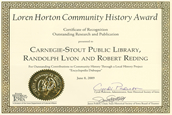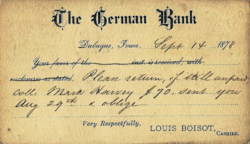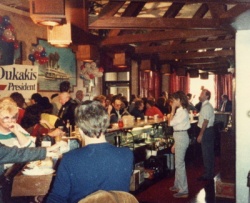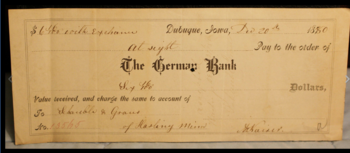Encyclopedia Dubuque
"Encyclopedia Dubuque is the online authority for all things Dubuque, written by the people who know the city best.”
Marshall Cohen—researcher and producer, CNN
Affiliated with the Local History Network of the State Historical Society of Iowa, and the Iowa Museum Association.
GERMAN SAVINGS BANK: Difference between revisions
No edit summary |
No edit summary |
||
| (32 intermediate revisions by the same user not shown) | |||
| Line 1: | Line 1: | ||
[[Image:DSC01084_1.jpg|left|thumb|250px|]] | [[Image:DSC01084_1.jpg|left|thumb|250px|]] | ||
On October 14, 1864 the formation of the German Savings Bank was announced. The founders purchased the former banking office of the Langworthy brothers. (1) [[JUNKERMANN, Karl Frederick "Otto"|Karl Frederick "Otto" JUNKERMANN]] and William Westphal were sent to St. Louis to observe operations in a similar German bank. The articles of incorporation for the German Savings Bank were made public the next day. Included among the incorporators were: | |||
[[HENRY BAADE]], grocer | |||
Hennan Brinkman, pork packer | Hennan Brinkman, pork packer | ||
| Line 7: | Line 8: | ||
Jacob Christman, hardware salesman | Jacob Christman, hardware salesman | ||
Julius | [[HAAS, Julius W.|Julius W. HAAS]], druggist | ||
[[HERANCOURT, Valentine|Valentine HERANCOURT]], furniture maker | [[HERANCOURT, Valentine|Valentine HERANCOURT]], furniture maker | ||
| Line 13: | Line 14: | ||
[[HEEB, Anton|Anton HEEB]], owner of a brewery | [[HEEB, Anton|Anton HEEB]], owner of a brewery | ||
[[WILLIAM HINTRAGER]], grocer | |||
Henry Honach, coppersmith | Henry Honach, coppersmith | ||
| Line 23: | Line 24: | ||
J. H. Kroesen, leather dealer | J. H. Kroesen, leather dealer | ||
Adam | [[JAEGER, Adam Francis|Adam Francis JAEGER]], wine and liquor salesman | ||
Otto Junkermann, druggist | "Otto" Junkermann, druggist | ||
[[PLEINS, F. M.|F. M. PLEINS]], soap and candle manufacturer | |||
[[SCHMID, Titus|Titus SCHMID]], brewer | [[SCHMID, Titus|Titus SCHMID]], brewer | ||
[[SCHERR, Bernhard C.|Bernhard C. SCHERR]], brewer | |||
[[THEDINGA, John H.|John H. THEDINGA]] | [[THEDINGA, John H.|John H. THEDINGA]] | ||
| Line 37: | Line 38: | ||
[[TSCHIRGI, Mathias|Mathias TSCHIRGI]], brewer | [[TSCHIRGI, Mathias|Mathias TSCHIRGI]], brewer | ||
William | [[WESTPHAL, William|William WESTPHAL]], hardware salesman | ||
While the articles of incorporation were similar to others of the period, one article set this bank apart. It stated that no person could hold the office of president or be employed as cashier or teller unless they were capable of speaking and understanding the German language. (2) This article was not included when the articles were renewed in 1884. | |||
[[Image:gsb.jpg|left|thumb|250px|Photo courtesy: Donna Ginter]]The hours of banking operation were set at 9:00 a.m.-8:00 p.m. Monday through Friday. On Saturday the bank was open from 9:00 a.m. until 5:00 p.m. The bank opened for business on November 20, 1864, at 57 Main Street. The 1873-74 ''Dubuque City Directory'' listed 60 Main. | |||
[[ | The German Savings Bank survived the financial depression of 1873 and the panic caused by the failure of the [[MERCHANTS' NATIONAL BANK]] due to [[BABBAGE, Richard A.|Richard A. BABBAGE]]. In the same year, downtown [[STREETS]] were renumbered and 60 Main Street became 342 Main Street. In 1874 the Iowa Legislature passed a law prohibiting institutions calling themselves savings banks from any business other than savings. Effective January 15, 1875, German Savings Bank was renamed the German Bank. | ||
[[File:germansavingsbank.jpg|200px|thumb|left|]]The significance of the word "German" in the bank's name had lessened greatly by 1884 when all but three directors were non-German. | |||
German Bank underwent great change in leadership in 1890, and the next year it joined the [[DUBUQUE CLEARING HOUSE ASSOCIATION]], a local bank organization that established rules for the operations of member banks. Among the new directors of the bank was [[SCHRUP, Nicholas J. Sr.|Nicholas J. SCHRUP, Sr.]] | |||
[[Image:GB1.png|right|thumb|250px|]]Banking operations were conducted on the first floor. Apartments were built on the upper two stories. The beautiful building did not, however, hide the fact that the bank had been growing more slowly than its competitors. In 1904 the articles of incorporation were renewed with the addition of an amendment that returned the bank to the status of a "savings bank." The institution was renamed the German Savings Bank. The articles also called for the establishment of a branch bank. On January 1, 1905 a north end branch of the bank was established at 18th and Couler (Central). (3) | |||
The 18th Street and Couler Avenue branch of the German Savings Bank continued to grow in popularity. The board of directors of the bank met on October 14, 1911 and discussed the organization of a savings bank to replace the branch. This became the [[GERMAN AMERICAN SAVINGS BANK]]. | |||
The | The outbreak of [[WORLD WAR I]] saw anti-German sentiment sweeping the United States. In Dubuque both the German Savings and German American Savings Bank felt that their business was endangered by the word "German" in their names. In 1918 the German Savings Bank was renamed the Pioneer Savings Bank and Trust Company. (4) One year later the name was changed to the Pioneer Trust and Savings Bank. | ||
The | The announcement that the Pioneer Trust and Savings had merged with the Consolidated National Bank came on November 9, 1926. On January 1, 1927, the business records and employees of Pioneer moved to the Consolidated bank offices at Main and Sixth Streets. Less than six years later Consolidated National closed its doors, a victim of the [[GREAT DEPRESSION]]. | ||
The | In 1978 the building was placed on the [[NATIONAL REGISTER OF HISTORIC PLACES]]. At the time, a note was made of the contrast between the two styles used in the building's construction. John Spencer and W. Williamson, the team that also designed Dubuque's [[CARNEGIE-STOUT PUBLIC LIBRARY]], used [[GREEK REVIVAL ARCHITECTURE]] on the first floor and Renaissance Revival style on the top two stories. The columns, rosettes, and crown eagles over the second-floor windows are made of glazed terra cotta. | ||
The German Bank building became the home of taverns and restaurants including the [[NAVY CLUB (THE)]] and the [[SILVER DOLLAR]] owned and operated by [[GINTER, Donna|Donna GINTER]]. In 2001 construction nearby on a parking ramp was blamed on cracks in walls in the German Bank and several other businesses. The presence of sub-basements used originally for storage may have contributed to the problem. The Building Services Department ordered the rear portions of buildings at 342, 36, 372, and 378 Main Street vacated forcing the businesses to temporarily close or relocate. | |||
In 2007 city officials entered into a development agreement with the German Bank Building, LLP, a building ownership group. The agreement required the developer to make a capital investment of $1.5 million in exchange for a $300,000 low-interest loan. The developers sold the property to James Madison, LLC in 2012. This shifted all the obligations including the development agreement to the new owners. The Mainstreet Steak and Chophouse opened at the site in 2013, but closed in early 2015. (5) | |||
In 2015 the City Council approved an inter-creditor agreement between the city and [[PREMIER BANK]] which would enable to bank to sell the German Bank Building as a result of the owners being in default of mortgages from the city and the bank. This was the first local instance of a business defaulting on a loan provided through the Downtown Rehabilitation Loan Program. Seventeen successful projects had occurred in the last two decades with nine more planned through 2026. The agreement would allow the city to recoup some of the outstanding balance of a $300,000 loan. The city, however, was still likely to lose nearly $100,000.(6) | |||
[[Image:exterior.jpg|left|thumb|250px|The removal of the fire escape when the top floors were no longer rented allowed more of the Renaissance Revival architecture to be visible. Photo courtesy: Donna Ginter]] | |||
[[Image:sdginter.jpg|left|thumb|250px|Donna Ginter serves up refreshments in front of the Silver Dollar. Photo courtesy: Donna Ginter]] | |||
[[Image:interiorsd.jpg|right|thumb|250px|Interior view of the Silver Dollar. Photo courtesy: Donna Ginter]] | |||
[[Image:vault.jpg|left|thumb|250px|Donna Ginter used the old bank vault to store food. Photo courtesy: Donna Ginter]] | |||
[[Image:dining.jpg|right|thumb|250px|Dining room at the German Bank (circa 1950s). Photo courtesy: Donna Ginter]] | |||
[[Image:GB21.png|right|thumb|350px|]] | |||
See: [[BANKS AND BANKING]] | |||
See: [[PANIC OF 1873]] | |||
--- | |||
Source: | |||
1. "German Banking House," ''Dubuque Democratic Herald'', October 14, 1864, p. 4. Online: https://news.google.com/newspapers?nid=A36e8EsbUSoC&dat=18641014&printsec=frontpage&hl=en | |||
2. Bragg, Mary Rae. "German Bank Not Just Another Pretty Facade," ''Telegraph Herald'', January 22, 2001, p. 1. Online: http://news.google.com/newspapers?id=OANaAAAAIBAJ&sjid=UEsNAAAAIBAJ&pg=3171,4166938&dq=history+of+german+bank+dubuque&hl=en | |||
3. U. S. Bank Profiles. Online: http://www.bankencyclopedia.com/American-Trust-Savings-Bank-13150-Dubuque-Iowa.html#ovHistory | |||
4. Cooper, Brian. "Reconfiguring Words: Why?," ''Telegraph Herald'', May 18, 2003, p. 3. Online: http://news.google.com/newspapers?id=nsRFAAAAIBAJ&sjid=470MAAAAIBAJ&pg=6490,3464523&dq=german+savings+bank+history+dubuque&hl=en | |||
5. Montgomery, Jeff. "City Program Faces 1st Default of Business Loan in 19 Years," ''Telegraph Herald'', April 16, 1915, p. 1 | |||
6. Ibid. p. 2A | |||
Interview with Donna Ginter November 1, 2010 | |||
"Our History...the Beginning," an American Trust Publication, compiled by [[ENZLER, Jerry|Jerry ENZLER]], Winter 2011 | |||
"Butchers, Bankers, and Cabinet Makers," Booklet accompanying the Robert Reding exhibit at the [[OLD JAIL]] 2007-2010. | |||
Latest revision as of 18:05, 23 November 2016
On October 14, 1864 the formation of the German Savings Bank was announced. The founders purchased the former banking office of the Langworthy brothers. (1) Karl Frederick "Otto" JUNKERMANN and William Westphal were sent to St. Louis to observe operations in a similar German bank. The articles of incorporation for the German Savings Bank were made public the next day. Included among the incorporators were:
HENRY BAADE, grocer
Hennan Brinkman, pork packer
Jacob Christman, hardware salesman
Julius W. HAAS, druggist
Valentine HERANCOURT, furniture maker
Anton HEEB, owner of a brewery
WILLIAM HINTRAGER, grocer
Henry Honach, coppersmith
J. Nicklaus
Peter KIENE, insurance agent
J. H. Kroesen, leather dealer
Adam Francis JAEGER, wine and liquor salesman
"Otto" Junkermann, druggist
F. M. PLEINS, soap and candle manufacturer
Titus SCHMID, brewer
Bernhard C. SCHERR, brewer
Mathias TSCHIRGI, brewer
William WESTPHAL, hardware salesman
While the articles of incorporation were similar to others of the period, one article set this bank apart. It stated that no person could hold the office of president or be employed as cashier or teller unless they were capable of speaking and understanding the German language. (2) This article was not included when the articles were renewed in 1884.
The hours of banking operation were set at 9:00 a.m.-8:00 p.m. Monday through Friday. On Saturday the bank was open from 9:00 a.m. until 5:00 p.m. The bank opened for business on November 20, 1864, at 57 Main Street. The 1873-74 Dubuque City Directory listed 60 Main.
The German Savings Bank survived the financial depression of 1873 and the panic caused by the failure of the MERCHANTS' NATIONAL BANK due to Richard A. BABBAGE. In the same year, downtown STREETS were renumbered and 60 Main Street became 342 Main Street. In 1874 the Iowa Legislature passed a law prohibiting institutions calling themselves savings banks from any business other than savings. Effective January 15, 1875, German Savings Bank was renamed the German Bank.
The significance of the word "German" in the bank's name had lessened greatly by 1884 when all but three directors were non-German.
German Bank underwent great change in leadership in 1890, and the next year it joined the DUBUQUE CLEARING HOUSE ASSOCIATION, a local bank organization that established rules for the operations of member banks. Among the new directors of the bank was Nicholas J. SCHRUP, Sr.
Banking operations were conducted on the first floor. Apartments were built on the upper two stories. The beautiful building did not, however, hide the fact that the bank had been growing more slowly than its competitors. In 1904 the articles of incorporation were renewed with the addition of an amendment that returned the bank to the status of a "savings bank." The institution was renamed the German Savings Bank. The articles also called for the establishment of a branch bank. On January 1, 1905 a north end branch of the bank was established at 18th and Couler (Central). (3)
The 18th Street and Couler Avenue branch of the German Savings Bank continued to grow in popularity. The board of directors of the bank met on October 14, 1911 and discussed the organization of a savings bank to replace the branch. This became the GERMAN AMERICAN SAVINGS BANK.
The outbreak of WORLD WAR I saw anti-German sentiment sweeping the United States. In Dubuque both the German Savings and German American Savings Bank felt that their business was endangered by the word "German" in their names. In 1918 the German Savings Bank was renamed the Pioneer Savings Bank and Trust Company. (4) One year later the name was changed to the Pioneer Trust and Savings Bank.
The announcement that the Pioneer Trust and Savings had merged with the Consolidated National Bank came on November 9, 1926. On January 1, 1927, the business records and employees of Pioneer moved to the Consolidated bank offices at Main and Sixth Streets. Less than six years later Consolidated National closed its doors, a victim of the GREAT DEPRESSION.
In 1978 the building was placed on the NATIONAL REGISTER OF HISTORIC PLACES. At the time, a note was made of the contrast between the two styles used in the building's construction. John Spencer and W. Williamson, the team that also designed Dubuque's CARNEGIE-STOUT PUBLIC LIBRARY, used GREEK REVIVAL ARCHITECTURE on the first floor and Renaissance Revival style on the top two stories. The columns, rosettes, and crown eagles over the second-floor windows are made of glazed terra cotta.
The German Bank building became the home of taverns and restaurants including the NAVY CLUB (THE) and the SILVER DOLLAR owned and operated by Donna GINTER. In 2001 construction nearby on a parking ramp was blamed on cracks in walls in the German Bank and several other businesses. The presence of sub-basements used originally for storage may have contributed to the problem. The Building Services Department ordered the rear portions of buildings at 342, 36, 372, and 378 Main Street vacated forcing the businesses to temporarily close or relocate.
In 2007 city officials entered into a development agreement with the German Bank Building, LLP, a building ownership group. The agreement required the developer to make a capital investment of $1.5 million in exchange for a $300,000 low-interest loan. The developers sold the property to James Madison, LLC in 2012. This shifted all the obligations including the development agreement to the new owners. The Mainstreet Steak and Chophouse opened at the site in 2013, but closed in early 2015. (5)
In 2015 the City Council approved an inter-creditor agreement between the city and PREMIER BANK which would enable to bank to sell the German Bank Building as a result of the owners being in default of mortgages from the city and the bank. This was the first local instance of a business defaulting on a loan provided through the Downtown Rehabilitation Loan Program. Seventeen successful projects had occurred in the last two decades with nine more planned through 2026. The agreement would allow the city to recoup some of the outstanding balance of a $300,000 loan. The city, however, was still likely to lose nearly $100,000.(6)
See: BANKS AND BANKING See: PANIC OF 1873
---
Source:
1. "German Banking House," Dubuque Democratic Herald, October 14, 1864, p. 4. Online: https://news.google.com/newspapers?nid=A36e8EsbUSoC&dat=18641014&printsec=frontpage&hl=en
2. Bragg, Mary Rae. "German Bank Not Just Another Pretty Facade," Telegraph Herald, January 22, 2001, p. 1. Online: http://news.google.com/newspapers?id=OANaAAAAIBAJ&sjid=UEsNAAAAIBAJ&pg=3171,4166938&dq=history+of+german+bank+dubuque&hl=en
3. U. S. Bank Profiles. Online: http://www.bankencyclopedia.com/American-Trust-Savings-Bank-13150-Dubuque-Iowa.html#ovHistory
4. Cooper, Brian. "Reconfiguring Words: Why?," Telegraph Herald, May 18, 2003, p. 3. Online: http://news.google.com/newspapers?id=nsRFAAAAIBAJ&sjid=470MAAAAIBAJ&pg=6490,3464523&dq=german+savings+bank+history+dubuque&hl=en
5. Montgomery, Jeff. "City Program Faces 1st Default of Business Loan in 19 Years," Telegraph Herald, April 16, 1915, p. 1
6. Ibid. p. 2A
Interview with Donna Ginter November 1, 2010
"Our History...the Beginning," an American Trust Publication, compiled by Jerry ENZLER, Winter 2011
"Butchers, Bankers, and Cabinet Makers," Booklet accompanying the Robert Reding exhibit at the OLD JAIL 2007-2010.











